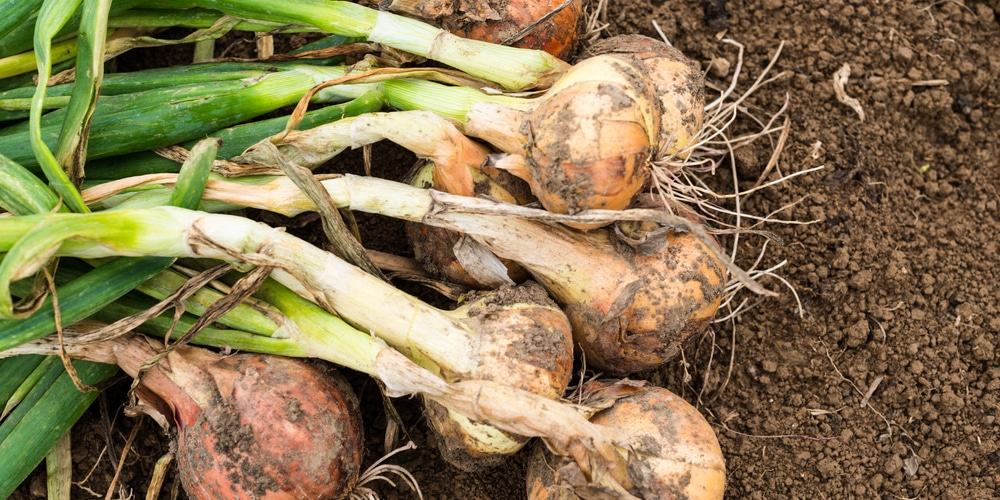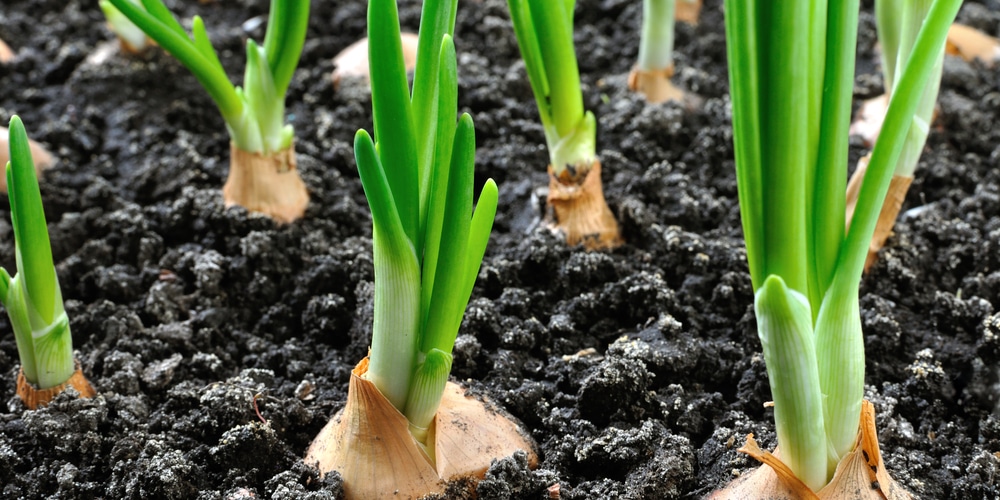Many Midwesterners in America might know a lot about onions. They understand how to make a mean onion soup, sauté the perfect onions for their salad, and know when to pull them out of the ground.
However, there are probably some things you do not know about this vegetable that could help you maximize your yield and save money on your garden. Here are aspects you should know when planting onions in Iowa.
When To Plant Onions In Iowa
You can plant the onion seeds in spring (mid to late April in Northern Iowa, early to mid-April in central Iowa, and late March or early April in Southern Iowa).
Once planted, onion plants need to grow all summer before they can start to produce the smallest bulb in response to the cold weather.
The ideal planting time for onion plants in your location is about six weeks before your first frost date in autumn. They will finish off for winter and provide you with a bountiful harvest next spring.
Each onion plant has different requirements – when it comes to soil pH and temperature. Ensure that soil pH is between 6.0 and 7.0; temperatures should be 55 degrees Fahrenheit at night, and during the day, they should never exceed 80 degrees Fahrenheit.
How To Plant Onions In Iowa
Prepare the soil
Using a tiller or rototiller, break up any clumps of soil and mix it with 2 inches of compost for every 10 feet of row space.
If using a rototiller, break up any lumps with the back tines first, and then use the front tines to mix the compost evenly into each hole. Rake over the surface level to smooth out any bumps or divots after aerating.
Sow the Onion Seeds
Spread the onion seeds evenly over the planted bed. Plant them 1/2 to 1 inch deep, depending on the size of the seed.
You can make rows 4 to 5 inches apart and plant 4 to 6 seeds per foot in each row. If planting green onions or scallions, thinly spread them over a wide area directly on top of the soil to grow them as a leaf crop for salads or stir fry rather than an onion bulb crop.
Water the Seedbeds
Water lightly with a gentle spray until you see runoff from underneath. Allow the soil to drain completely, then add light spray (2-3 gallons per acre or 111-133 grains per 1000 square-feet).
Mulch the Seedbed
Cover the seedbed with a 1-inch layer of composted manure (or 2 to 3 inches of chopped grass clippings) and cover that evenly with another layer of plastic mulching.
Pellets or plastic mulched are preferred because they remain in place better than grass clippings.
Cultivate the Soil
To prevent erosion, dig in some more compost and topdress with 1 to 2 inches of composted manure. Repeat this process yearly to keep the soil fertile and increase nitrogen availability.
Plant the Onions
Plant your onion seeds according to their size. Water them daily once they start sprouting (unless you live in an area that rarely receives rain). Put them on a drip irrigation system directly into the mulch until they germinate or get close enough in height where you can easily see them under your hand-stretched over the row.
Once the tops of the plants come up through the mulch, you can start weeding them. Do not weed while they are still under the mulch, as they need to be able to reach sunlight directly.
Onions can be grown in rows or between other plants such as tomatoes, corn, or marigolds. Rows should be 4 feet wide and 12 inches apart with 1 inch between each plant within each row (or 2 feet by 6 inches when interplanted). Seed thickly to have 2 to 3 onions per bulb size when they mature.
When To Harvest Onions In Iowa
Onions are ready for harvesting around 90-120 days after planting. Planting dates vary depending on the region, so check with your local garden center for the recommended planting time for your area.
If you planted too late and the onion leaves start looking yellow – it is probably best not to pick them and just let them die off naturally.
If the tops of the onion plants start to fall over and turn brown, it means that the onions have matured, and you should probably be harvesting them in Iowa. If you pull on a mature onion bulb, it should come out with more ease.
One way to tell if your onions are ready is to check for a bulge on the outside of the plant. If there is a bulge, then this means that there is an onion growing inside.
The bulge penetrates through the skin, and you will feel something firm on the inside when you touch it. At the same time, some people can tell if their onions are ready to harvest by just looking at the leaves.
They should be beginning to turn yellow and dry out somewhat.
After you harvest your onions, you need to dry them as much as possible before storing them in Iowa.
The best time to do this is between 10 and 30 days after you harvested them; this will ensure they maintain their taste and texture perfectly until they are consumed.
Challenges With Growing Onions In Iowa
When it comes to growing onions in Iowa, a few challenges are unique to this specific state. With these challenges in mind, you may want to know how they can impact your onion growing experience. Read this article for more info!
Low Temperatures
Iowa has a relatively low temperature during the winter months. In general, the average temperature in Iowa ranges from 30-40 degrees Fahrenheit throughout most of the year.
To grow onions successfully, you will need a reliable heat source close by with no fluctuation between day and night throughout your season. It is challenging for many gardeners and growers to grow onions without experiencing onion death.
Low Humidity Levels
If your residential area has low humidity levels, it can be challenging to grow onions successfully throughout all four seasons. That is due to the lack of rain throughout the entire season in some cases.
However, in other cases, the temperatures during the summer and winter months can cause this low humidity level.
Pests and diseases
i) Onion maggot: Looks like a light brown moth with a long nose. It causes young onion plants to wither and die because they deprive them of water by laying eggs on the roots or at their base, where they suck the plant’s juices out through their “fleshy mouth.” When maggots hatch, they feed on the plant’s roots. The only control measure comes in row sanitation as these pests are only active in the soil.
ii) Soil-borne mosaic: This disease is caused by phytoplasmas (a bacterial-like parasite). The disease causes stunted plants, delayed bulb development, discolored leaves and shoots, and leaf mottling. It infects plants through their roots. There are no controls against soil-borne mosaic other than not to grow onions near infected plants or fields that had a previous outbreak.
iii) Onion thrips: This is a tiny, yellowish insect that can be controlled by spraying with insecticides.
iv) Onion volatiles: A chemical called “volatile” causes the onion to wither and die if exposed. There are no actions recommended for this other than not exposing your plants to it and whatever precautions you have for other crop diseases.
v) Anthracnose: A problem where symptoms resemble those of sooty mold or anthrax. It looks like black specks and can be confused with anthrax and sooty mold.
The disease is primarily found on the roots and stems of onions. The best control for this disease is to grow onions only in susceptible areas. Spacing your onions out will help prevent this disease and apply crop protection fungicides.
When to plant onions in Iowa: Conclusion
The soil from Iowa, the United States state that yields the world’s largest onion crop is suitable for growing onions. However, onion growers in Iowa face several challenges in raising their crops.
One of these challenges is planting onions in the right location and time to grow tall enough before the summer heat, and weeds burn them down.
Apart from that, onions need good moisture and fertility to stay sweet even as they get larger.
Related Article: Is Onion a Vegetable?


